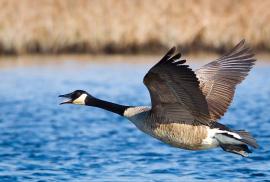Guide to Boreal Birds
Overview
Well known for their V-shaped migrating flocks and rich, sonorous honking, Canada Geese are among the most familiar of North America's waterfowl. There were formely 11 geographical races recognized, but the smaller races have recently been established as a separate species, called the Cackling Goose (B. hutchinsonii). The larger races, ranging in size from the "Giant Canada Goose" of the northern prairies to the much smaller "Lesser," remain part of the Canada Goose complex. The most abundant race is the one that nests south of Hudson Bay, which numbers well over a million. Like other geese, these birds are chiefly grazers, feeding on stubble fields and eating marsh vegetation. Increasingly tolerant of humans, some Canadas even nest in city parks and suburbs. They are especially noticeable in late summer and early fall, when they form molting flocks on golf courses and large lawns; at such times, they have come to be regarded as pests.
Description
35-45" (89-114 cm). Brownish body with black head, long black neck, conspicuous white cheek patch. The smaller Brant has a shorter neck and lacks white cheek patch. The Cackling Goose is smaller, darker, shorter-billed, and found mainly in the West.
Voice
Rich musical honking.
Nesting
4-8 whitish eggs in a large mass of grass and moss lined with down; usually on the ground near water or on a muskrat lodge, but sometimes in a tree in an abandoned Osprey or Bald Eagle nest.
Habitat
Lakes, bays, rivers, and marshes. Often feeds in open grasslands and stubble fields.
Range/Migration
Breeds from Alaska east to Baffin Island and south to California, Illinois, and Massachusetts. Winters south to northern Mexico and Gulf Coast. Widespread as a semi-domesticated bird in city parks and on reservoirs.



